 One of the first discoveries about the unusual behavior and cognitive abilities of bacteria was a signal put out by many of the members of a community to make a group decision. This “quorum sensing” signal stimulates collaborative attacks and migration by sensing if there are enough providing signals to carry out the activity. Later, it was learned that each bacterium has many remarkable communication skills that allow them to manipulate the much larger and more complex human cells. These capacities make us even wonder if bacteria somehow have a brain. The list of brain like qualities in these tiny single celled creatures are listed below.
One of the first discoveries about the unusual behavior and cognitive abilities of bacteria was a signal put out by many of the members of a community to make a group decision. This “quorum sensing” signal stimulates collaborative attacks and migration by sensing if there are enough providing signals to carry out the activity. Later, it was learned that each bacterium has many remarkable communication skills that allow them to manipulate the much larger and more complex human cells. These capacities make us even wonder if bacteria somehow have a brain. The list of brain like qualities in these tiny single celled creatures are listed below.
Even more surprisingly, much tinier viruses have been observed with complex behavior and the ability to manipulate human cells. Viruses are really just a small strand of DNA or RNA that can manufacture enough proteins to survive, travel, and reproduce. But, somehow with these proteins—sometimes as few as 9 (see posts on HIV and Ebola)—they exhibit elaborate evasion techniques of the vastly more complex human immune system. It has been assumed that viruses must use signals for these elaborate behaviors, but they have been too small to observe direct communication. Until now.
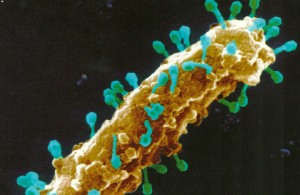 Very recently a dramatic finding is a set of small peptide signals used by phage viruses to communicate. Phages are the class of viruses that invade and manipulate bacteria rather than human cells. Phage viruses are somehow able to hijack the much more complex bacteria genetic machinery to evade capture and to make copies of themselves. This newly discovered signal goes out to the community of phage viruses and changes their behavior. While it has been clear that viruses must communicate in some ways in order to function the way they do, this is the first actual communication signal and system ever observed.
Very recently a dramatic finding is a set of small peptide signals used by phage viruses to communicate. Phages are the class of viruses that invade and manipulate bacteria rather than human cells. Phage viruses are somehow able to hijack the much more complex bacteria genetic machinery to evade capture and to make copies of themselves. This newly discovered signal goes out to the community of phage viruses and changes their behavior. While it has been clear that viruses must communicate in some ways in order to function the way they do, this is the first actual communication signal and system ever observed.
To Kill or Rest
 One of the major decisions phage viruses make is whether to infect and live inside of bacteria versus killing it. By killing the bacteria, the viruses that have already been produced are released to infect other cells. But, by staying in the bacteria the virus can continue to make copies. Also, they won’t use up all the bacteria they need to survive and reproduce.
One of the major decisions phage viruses make is whether to infect and live inside of bacteria versus killing it. By killing the bacteria, the viruses that have already been produced are released to infect other cells. But, by staying in the bacteria the virus can continue to make copies. Also, they won’t use up all the bacteria they need to survive and reproduce.
Sometimes phage viruses even become part of the bacterial lifestyle and are beneficial to the bacteria. (They can also be beneficial to humans in some cases, such as defending gut lining cells in the mucous barrier). They often transport vital information among the members of the bacteria community, such as genes that allow resistance to antibiotics. In fact, bacteria have been found that essentially manufacture their own viruses as a way of sending information, along with the many other ways they signal, such as by building complex syringe-like devices that inject molecules into cells.
Viruses are vastly smaller than bacteria, which are vastly smaller than human cells. Being so tiny, technology is just now beginning to be able to observe virus behavior. When communication systems are discovered for viruses that attack human cells, then an entirely new medical era will dawn where these signals can be intercepted as medical treatments. This is analogous to the current era of medical treatment where signals among bacteria, immune cells, gut cells, brain cells, and many others can be used in treatments for cancer. In view of their very elaborate behaviors, no doubt more and more communication signals will be discovered in the future. This signal was found in phages that attacks Bacillus bacteria.
The Microbe “Brain”
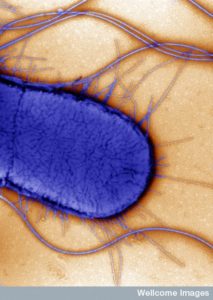 ndividual microbes solve complex problems from multiple inputs, such as locating food and evading predators. They communicate to decide on complex community activity.
ndividual microbes solve complex problems from multiple inputs, such as locating food and evading predators. They communicate to decide on complex community activity.
- Microbe cell membranes have specific regions that act as sensory organs from chemical or mechanical signals some forming a lattice of hexagonal shaped receptors. They pick up specific chemicals and are part of large systems that can respond to many different chemical changes in the environment. This is like sensory neurons in the brain that trigger actions.
- Microbes use electrical signals sent from one part of the bacteria to another, such as to the cilia to change its movements. This is like the neuron action potential.
- Microbes use contracting proteins to move and spread, like neurons navigate throughout the brain and build axons.
- Microbes send chemical signals to other cells that have a wide range of actions. This is similar to neurotransmitters and cytokines. In fact, microbes make these same signals.
- Microbes integrate many signals—temperature, chemical, and touch—and make decisions about future actions. This is similar to the brain.
- Microbes act as individuals or in a group. They move without outside triggers looking for food and respond to the time of day. This is similar to the brain.
In fact, viruses do many of these same behaviors, but the research is just beginning and it is not understood how they can have such complex behviors.
Intelligent Virus Activity
 Some think viruses are not alive. But, for something so simple their behavior is quite remarkable. They are able to evade the search and destroy systems of huge human cells and organs. Viruses can trick the pattern receptors in human cells in many different ways. They can interfere with them, hide from them, or modify pathways as well as specific molecular adaptors. They do this with a very small number of proteins that perform many complex actions, not just building their space ship to travel between cells.
Some think viruses are not alive. But, for something so simple their behavior is quite remarkable. They are able to evade the search and destroy systems of huge human cells and organs. Viruses can trick the pattern receptors in human cells in many different ways. They can interfere with them, hide from them, or modify pathways as well as specific molecular adaptors. They do this with a very small number of proteins that perform many complex actions, not just building their space ship to travel between cells.
Ebola has only 7 genes and 7 proteins. It can build a very large complex vessel for travel. It evades and tricks many pathways to enter the cell, where it evades sensors and even is able to build a decoy to confuse the human immune system. It hijacks the vital protein rafts in the cell’s membrane and uses it for many different purposes.
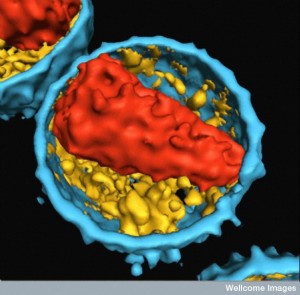 HIV has 9 genes and proteins. It also enters the cell, evades the immune system, and then travels into the highly protected nucleus to place its DNA. They it tricks many systems to escape from the cell. It often travels in special nanotubes between cells.
HIV has 9 genes and proteins. It also enters the cell, evades the immune system, and then travels into the highly protected nucleus to place its DNA. They it tricks many systems to escape from the cell. It often travels in special nanotubes between cells.
The larger Herpes virus has more genes (70), but still a tiny amount compare with bacteria. It has a very complex lifestyle including hijacking the complex motors that travel along microtubules in neurons. It changes its behavior multiple times—becomes quiet in the nucleus of the neuron and then reactivates itself.
Humans have, perhaps, ten trillion cells (one trillion in the brain), with ten times more bacteria. But, there are 100 times more phage viruses than bacteria. The number of phage viruses on earth is 10 to the power of 31 (10 with 31 zeroes). Phage are the most numerous creatures with the most species on earth.
Viruses can be harmful and helpful to bacteria. It is a fierce intelligent battle that is unusual in that specific genes make newly edited molecules to be used as weapons. The creation of these back and forth weapons occurs all of the time. In this battle new antibiotics are produced by the microbes themselves. They can use alternative RNA splicing to make these new weapons.
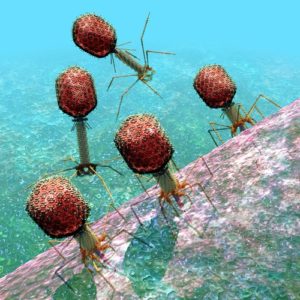 Phages are a driving force in evolution and use a large number of different tactics to invade and overcome barriers. They make new receptors, find hidden receptors, and can use timing of several different receptors at once.
Phages are a driving force in evolution and use a large number of different tactics to invade and overcome barriers. They make new receptors, find hidden receptors, and can use timing of several different receptors at once.
Bacteria cut DNA in many ways and viruses avoid this in an equal number of ways. CRISPR was discovered as the private immune systems of bacteria against viruses and now it is found that there are many different kinds of CRISPR in different bacteria. Bacteria can alter their CRISPR in real time for a new virus threat. The bacteria make toxins and viruses make many antitoxins (at least five completely different toxin-antitoxin systems are documented). The effects are based on the folded shapes of molecules. Somehow bacteria and even viruses make specific molecules of particular shapes, which is how they work. Meanwhile human supercomputers cannot figure out protein folding yet.
The phage is proactive in avoiding being cut by CRISPR by producing two proteins that bind to their viral DNA protecting vital regions. It also creates a mimic DNA so the cell can cut that one. Viruses add methyl tags to alter their DNA as well as modified unusual tags to confuse the bacteria.
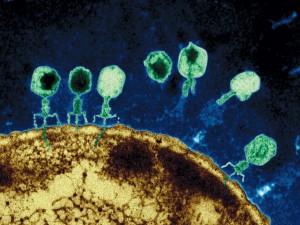 Another complex behavior and mechanism is phage interacting with the large proteins that fold all proteins. Chaperone molecules help fold both the bacterial and virus creations. The bacteria can change the chaperone molecule by editing (mutating) its DNA. The virus also alters its product to work with the new mutated chaperone. One virus makes its own parts for the chaperone molecule in order to build the virus cover. Bacteria mutate their reproduction machinery in defense. Phage counter this is multiple ways. Some bacteria commit suicide when infected to altruistically help their community. Viruses are able to stop this programmed death by altering the machinery.
Another complex behavior and mechanism is phage interacting with the large proteins that fold all proteins. Chaperone molecules help fold both the bacterial and virus creations. The bacteria can change the chaperone molecule by editing (mutating) its DNA. The virus also alters its product to work with the new mutated chaperone. One virus makes its own parts for the chaperone molecule in order to build the virus cover. Bacteria mutate their reproduction machinery in defense. Phage counter this is multiple ways. Some bacteria commit suicide when infected to altruistically help their community. Viruses are able to stop this programmed death by altering the machinery.
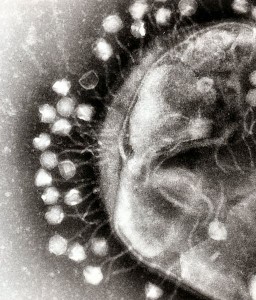 Phage predict future actions of the bacteria and produce multiple proteins for the different phases of the life cycle of the bacteria. They have different receptor proteins that respond at different times in the future based on the growth phases.
Phage predict future actions of the bacteria and produce multiple proteins for the different phases of the life cycle of the bacteria. They have different receptor proteins that respond at different times in the future based on the growth phases.
Phage produce special molecules to bind to bacteria receptors (proteins, polysaccharides, and lipopolysaccharides (LPS)). Phage modify their receptor proteins, some build several to bind at several places at once (one needed four mutations/edits). When bacteria evolve new ones, phage do also.
The Arbitrium Phage Virus Communication System
The new term for this phage communication system—arbitrium for “decision”—was given by the discovers last week. This research began looking for ways that Bacillus subtilis signals other members of the bacteria community. Bacteria change their behaviors based on an array of chemical signals. Communication includes telling the group to reproduce more rapidly or to become more dangerous and create an infectious attack.
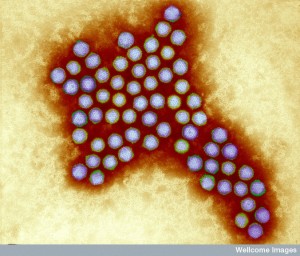 In this case, however, they found that it was a phage phi3T that creates the signal that alters the behavior of the many local phage viruses. Most of the time these phage viruses infect the bacteria and keep making more and more virus copies until the cell breaks open. They can also insert their own viral genes into the bacteria much the way retroviruses infect genes into the human genome. When these phage live in the bacteria genome, they can wait to make more viruses at any time in the future.
In this case, however, they found that it was a phage phi3T that creates the signal that alters the behavior of the many local phage viruses. Most of the time these phage viruses infect the bacteria and keep making more and more virus copies until the cell breaks open. They can also insert their own viral genes into the bacteria much the way retroviruses infect genes into the human genome. When these phage live in the bacteria genome, they can wait to make more viruses at any time in the future.
The newly discovered phage signals change the behavior of the community of phages and tells them to place their genes into the bacterial genome and wait instead of killing the bacteria.
Once the researchers realized that such a signal existed, it took more than two years to find it. When there is more of this small protein, phages stop killing bacteria and stays inside living bacteria. The virus in fact, produces two other proteins that are part of this process. One measures how much arbitrium there is present and the other helps with invasions in the future.
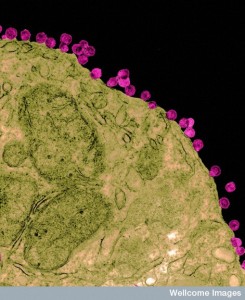 One possible reason for this conversation is when the number of bacteria are becoming too small and the virus needs to wait until there are larger numbers of bacteria for viruses to live in before killing them. Now, a hundred other communication systems have already been identified. But, the details will take years to be discovered and worked out since phage are so tiny. It appears that each phage has its own signals for their particular species.
One possible reason for this conversation is when the number of bacteria are becoming too small and the virus needs to wait until there are larger numbers of bacteria for viruses to live in before killing them. Now, a hundred other communication systems have already been identified. But, the details will take years to be discovered and worked out since phage are so tiny. It appears that each phage has its own signals for their particular species.
It is only a matter of time before major human virus communication systems will be found for other important viruses, such as HIV and herpes viruses, that can both cause quiet behavior as well as very active infections. Some wonder if signals could be produced to permanently produce the quiet state, it would be an effective cure in some circumstances.
Arbitrium Details
 Phage peptides used for the communication system involve six amino acids. Various phages make their own small peptide as a signal to other viruses. This peptide system has three genes—aimP makes the signal peptide; aimR makes the receptor for the peptide; and aimX a regulator molecule that can slow down the process if too many bacteria are being killed. This system allows the phage to know how many infections have occurred to determine whether to kill or go quiet.
Phage peptides used for the communication system involve six amino acids. Various phages make their own small peptide as a signal to other viruses. This peptide system has three genes—aimP makes the signal peptide; aimR makes the receptor for the peptide; and aimX a regulator molecule that can slow down the process if too many bacteria are being killed. This system allows the phage to know how many infections have occurred to determine whether to kill or go quiet.
Previous studies of Lambda phage for E. coli showed that this decision appeared to be related to the amount of food available and the number of phages present. Bacteria usually use peptides as signals for their quorum sensing.
Other details of the mechanism include the fact that aimP is secreted from the cell into the extra cellular space with two combining into a dimer there. AimR as a dimer then stimulates AimX.
- In bacteria, the peptide binds to a receptor that alters the genetic behavior of the cell.
- The phage system works when the three peptides are produced:
- AimR becomes a dimer and then stimulates more AimX.
- AimX blocks blocks the genetic pathway to insert the DNA into the bacteria and instead produces the kill cycle in as yet unknown mechanism.
- AimP stays in the extra cellular space as a dimer.
- When a new phage enters a bacteria, some of the peptides are taken in with it by a transporter. Inside the cell these bind to AimR receptor, which goes from a dimer to a monomer becoming inactive. This stops the AimX inhibition of lysogeny (quiet insertion) and produces the quiet state.
The First Virus Communication Signals
 This is the opening bell of an entirely new era of biology. It demonstrates that viruses do exhibit communication like bacteria and all other cells. As cellular communication is the basis of all biology, how far does communication extend into smaller creatures and even molecules?
This is the opening bell of an entirely new era of biology. It demonstrates that viruses do exhibit communication like bacteria and all other cells. As cellular communication is the basis of all biology, how far does communication extend into smaller creatures and even molecules?